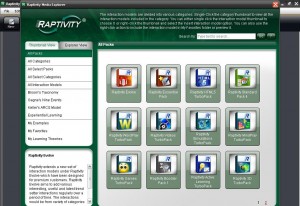Produced by Harbinger Group
Harbinger Group’s Raptivity – a wizard-led rapid development software tool that comes with a library of pre-built templates – is one of the few options available for the professional learning designer/ developer. Users of this versatile rapid interactivity builder tool can create stand-alone learning content – or import the file into another tool, such as Captivate, Articulate, Lectora, and almost any authoring tool that supports Flash or HTML5 files.
Recently updated to version 7.3, Raptivity is now well-established among designers/ developers, having been launched as long ago as 2005. It allows instructional designers and course developers to create learning interactions via a series of pre-built interaction templates. These enable users to produce learning materials and publish them to a Flash (.swf) and/or HMTL5 file format.
Users have access to over 180 pre-programmed Flash and over 100 HTML5 interactions including games, simulations, brainteasers, interactive diagrams and virtual worlds. This should be a sufficient selection for all but the most demanding designer/ developer. Moreover, each interaction category (game, simulation and so on) includes a number of different interactions – one of which is likely to be appropriate for any ‘learning situation’. The user merely has to add content to the chosen interaction.
One of the claims for rapid authoring tools is that users needn’t be overly proficient in the areas of instructional design/ learning theory, screen design, programming and so on. Indeed, using Raptivity involves no programming. Moreover, should the user be at all hazy on instructional design theory, the library of pre-built interaction templates can be browsed by instructional design theories – including Bloom’s Taxonomy, Gagné’s Nine Events and Keller’s ARCS – for suggested interactions that meet these theories’ requirements.
All the interaction models support SCORM 1.2 and 2004 as well as JavaScript tracking for Flash and HTML5. So the product (a 153Mb zipped file for the ‘Essential’ or basic program, augmented by a further four ‘Standard’, eight ‘Turbo’ and one ‘Booster’ packs) doesn’t appear to have interoperability issues.
Raptivity comes with an asset library of 120 commonly used images, covering education, science, computer, office, travel and transportation, shapes, backgrounds and buttons – and, via the software’s Media Toolbox, users can add extra media objects such as video, audio, images, text and buttons to the interaction models to enhance the learning experience.
Furthermore, ever since version 6, Raptivity has been capable of publishing content for mobile devices – which is a ‘must’ for modern rapid authoring and interactivity building tools.
In terms of pricing, discounts are available for education, government and non-profit organizations. The full price program costs some $625 (some £392) for the ‘Essential’ software (containing 35 interaction models with HTML5 and Flash support) and some $2,700 (some £1,690) for the Raptivity Himalaya Pack (the complete Raptivity software with over 180 interactivity models).
This is not unreasonable, considering what the user gets for this price – in terms of available interactions, templates, images, product features and so on. However, it’s debatable whether all but the most skilful or the most foolhardy user would explore – let alone use – the product in its entirety.
There is even the option to customise your copy of Raptivity, branding its output with your organisation’s logo and so on. And, with version 7.3, those who sign up for Harbinger Group’s support service get ‘Raptivity Evolve’, a service which – every four to six weeks – provides them with a new interaction for their collection.
Those who prize interactivity highly in the ‘industrial strength’ learning materials they develop should find that Raptivity meets many of their criteria for the ‘ideal rapid interactivity tool’. However, there’s almost too much choice in terms of interactions. Curbing the temptation to over-engineer learning materials with ever more – and increasingly elaborate – interactions is the designer/developer’s responsibility but at least, with Raptivity, that temptation exists.
Professional developers who understand instructional design theories and developing sophisticated learning materials for adults (as opposed to children) are the most likely to get the best out of Raptivity. While the amateur could be bewildered – and seduced – by the amount of choice on offer, the professional should be able to harness Raptivity’s undoubted versatility and abundance to build effective learning materials productively.







Leave A Comment
You must be logged in to post a comment.